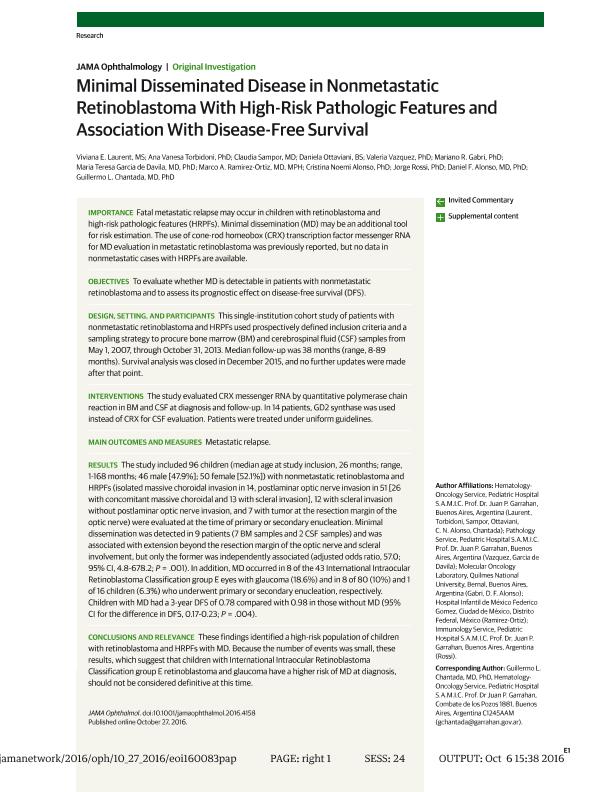Artículo
Minimal Disseminated Disease in Nonmetastatic Retinoblastoma With High-Risk Pathologic Features and Association With Disease-Free Survival
Laurent, Viviana Eunice ; Torbidoni, Ana Vanesa
; Torbidoni, Ana Vanesa ; Sampor, Claudia; Ottaviani, Daniela; Vazquez, Valeria; Gabri, Mariano Rolando
; Sampor, Claudia; Ottaviani, Daniela; Vazquez, Valeria; Gabri, Mariano Rolando ; Garcia de Davila, Maria Teresa; Ramirez Ortiz, Marco; Alonso, Cristina Noemí; Rossi,Jorge; Alonso, Daniel Fernando
; Garcia de Davila, Maria Teresa; Ramirez Ortiz, Marco; Alonso, Cristina Noemí; Rossi,Jorge; Alonso, Daniel Fernando ; Chantada, Guillermo Luis
; Chantada, Guillermo Luis
 ; Torbidoni, Ana Vanesa
; Torbidoni, Ana Vanesa ; Sampor, Claudia; Ottaviani, Daniela; Vazquez, Valeria; Gabri, Mariano Rolando
; Sampor, Claudia; Ottaviani, Daniela; Vazquez, Valeria; Gabri, Mariano Rolando ; Garcia de Davila, Maria Teresa; Ramirez Ortiz, Marco; Alonso, Cristina Noemí; Rossi,Jorge; Alonso, Daniel Fernando
; Garcia de Davila, Maria Teresa; Ramirez Ortiz, Marco; Alonso, Cristina Noemí; Rossi,Jorge; Alonso, Daniel Fernando ; Chantada, Guillermo Luis
; Chantada, Guillermo Luis
Fecha de publicación:
10/2016
Editorial:
American Medical Association
Revista:
JAMA Ophthalmology
ISSN:
2168-6165
Idioma:
Inglés
Tipo de recurso:
Artículo publicado
Clasificación temática:
Resumen
Importance: Fatal metastatic relapse may occur in children with retinoblastoma and high-risk pathologic features (HRPFs). Minimal dissemination (MD) may be an additional tool for risk estimation. The use of cone-rod homeobox (CRX) transcription factor messenger RNA for MD evaluation in metastatic retinoblastoma was previously reported, but no data in nonmetastatic cases with HRPFs are available.Objectives: To evaluate whether MD is detectable in patients with nonmetastatic retinoblastoma and to assess its prognostic effect on disease-free survival (DFS).Design, Setting, and Participants: This single-institution cohort study of patients with nonmetastatic retinoblastoma and HRPFs used prospectively defined inclusion criteria and a sampling strategy to procure bone marrow (BM) and cerebrospinal fluid (CSF) samples from May 1, 2007, through October 31, 2013. Median follow-up was 38 months (range, 8-89 months). Survival analysis was closed in December 2015, and no further updates were made after that point.Interventions: The study evaluated CRX messenger RNA by quantitative polymerase chain reaction in BM and CSF at diagnosis and follow-up. In 14 patients, GD2 synthase was used instead of CRX for CSF evaluation. Patients were treated under uniform guidelines.Main Outcomes and Measures: Metastatic relapse.Results: The study included 96 children (median age at study inclusion, 26 months; range, 1-168 months; 46 male [47.9%]; 50 female [52.1%]) with nonmetastatic retinoblastoma and HRPFs (isolated massive choroidal invasion in 14, postlaminar optic nerve invasion in 51 [26 with concomitant massive choroidal and 13 with scleral invasion], 12 with scleral invasion without postlaminar optic nerve invasion, and 7 with tumor at the resection margin of the optic nerve) were evaluated at the time of primary or secondary enucleation. Minimal dissemination was detected in 9 patients (7 BM samples and 2 CSF samples) and was associated with extension beyond the resection margin of the optic nerve and scleral involvement, but only the former was independently associated (adjusted odds ratio, 57.0; 95% CI, 4.8-678.2; P = .001). In addition, MD occurred in 8 of the 43 International Intraocular Retinoblastoma Classification group E eyes with glaucoma (18.6%) and in 8 of 80 (10%) and 1 of 16 children (6.3%) who underwent primary or secondary enucleation, respectively. Children with MD had a 3-year DFS of 0.78 compared with 0.98 in those without MD (95% CI for the difference in DFS, 0.17-0.23; P = .004).Conclusions and Relevance: These findings identified a high-risk population of children with retinoblastoma and HRPFs with MD. Because the number of events was small, these results, which suggest that children with International Intraocular Retinoblastoma Classification group E retinoblastoma and glaucoma have a higher risk of MD at diagnosis, should not be considered definitive at this time.
Palabras clave:
RETINOBLASTOMA
,
MINIMAL DISSEMINATION
,
EYE
,
TUMOR
Archivos asociados
Licencia
Identificadores
Colecciones
Articulos(SEDE CENTRAL)
Articulos de SEDE CENTRAL
Articulos de SEDE CENTRAL
Citación
Laurent, Viviana Eunice; Torbidoni, Ana Vanesa; Sampor, Claudia; Ottaviani, Daniela; Vazquez, Valeria ; et al.; Minimal Disseminated Disease in Nonmetastatic Retinoblastoma With High-Risk Pathologic Features and Association With Disease-Free Survival; American Medical Association; JAMA Ophthalmology; 134; 10-2016; 1374-1379
Compartir
Altmétricas



